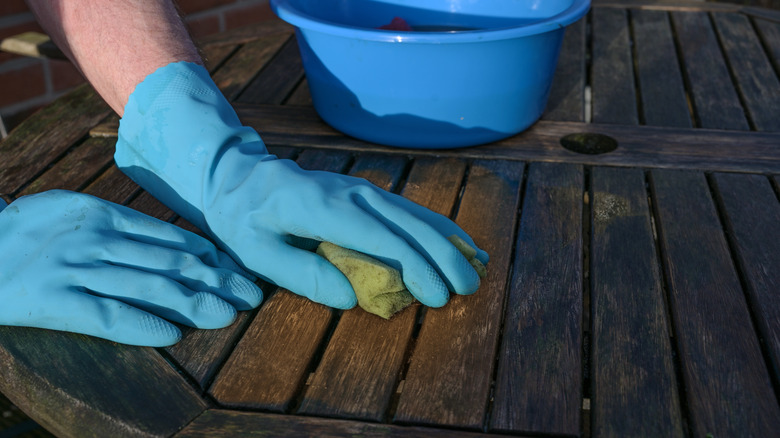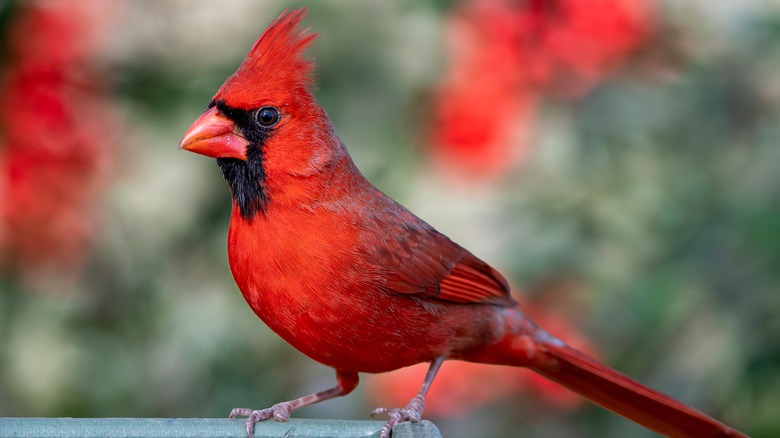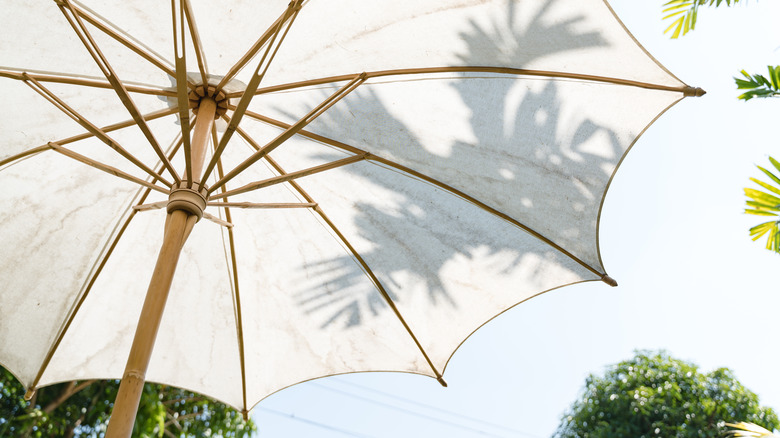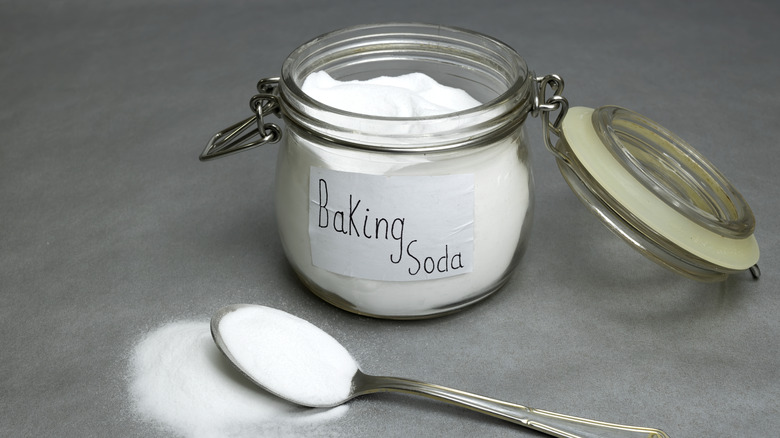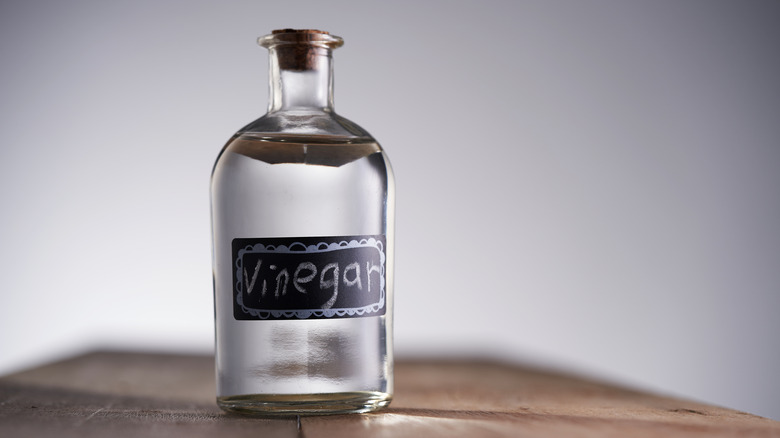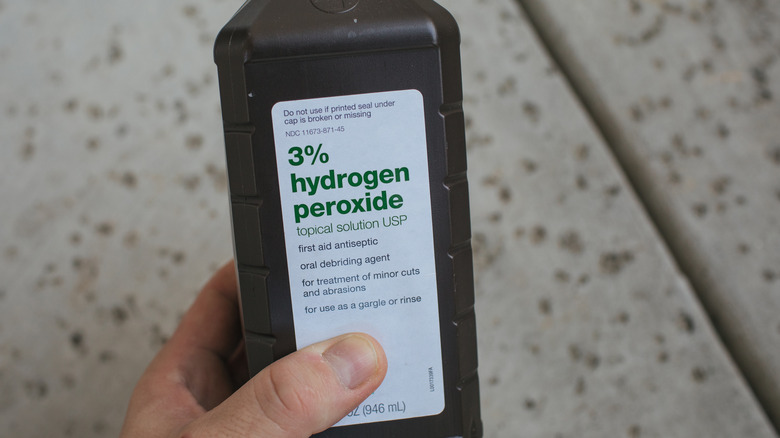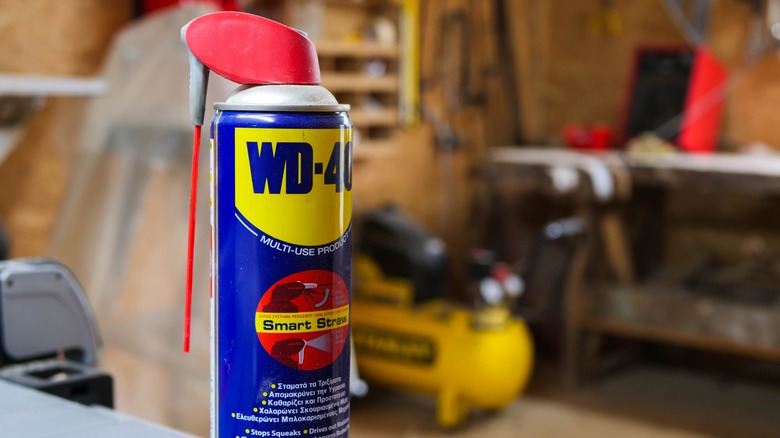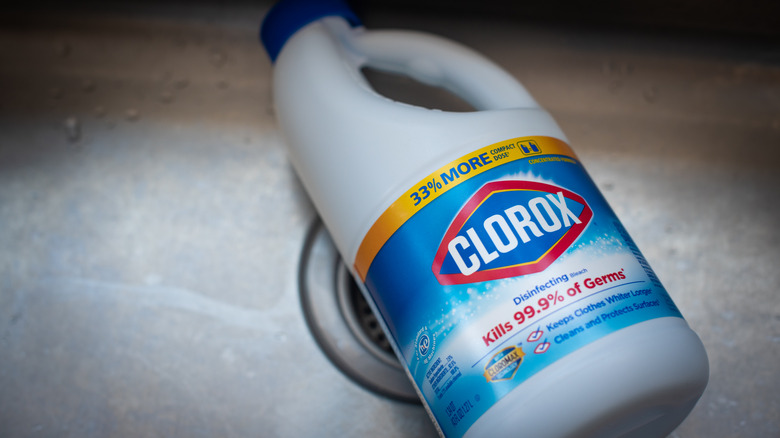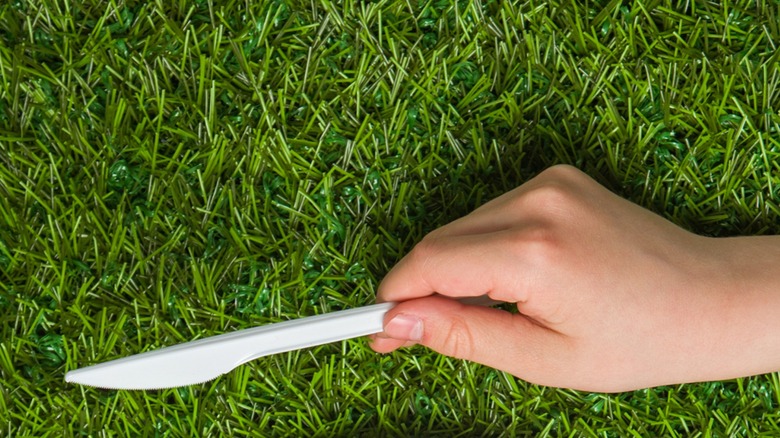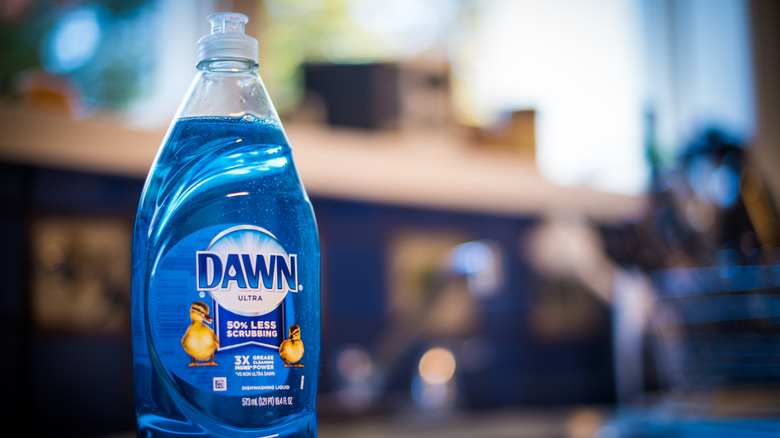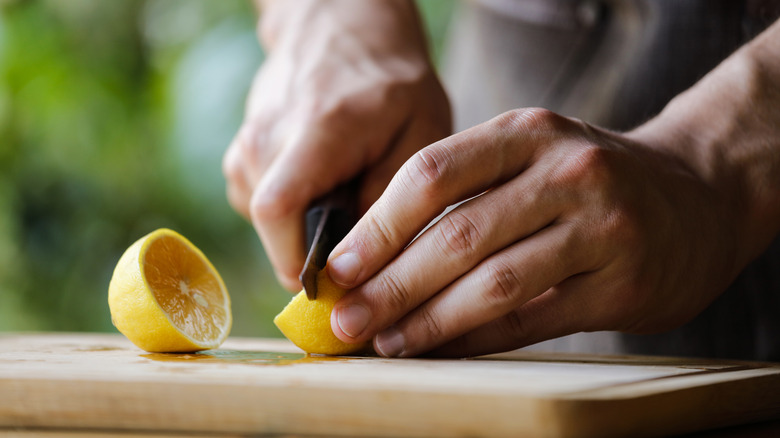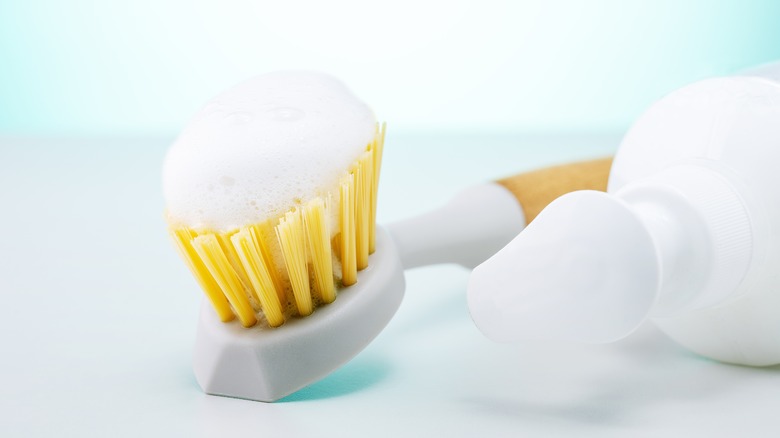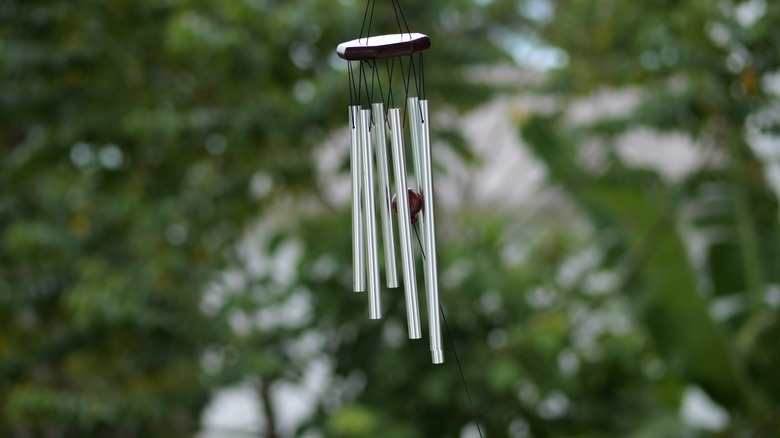The Best Methods For Removing Bird Poop Stains From Outdoor Furniture
Birds can enhance our yards greatly with their presence, antics, and song, but when nature calls they're capable of leaving a mess in their wake. The distinctive stain and splatter of bird poop on your lovingly picked garden furniture is enough to break the hardest heart. It doesn't just look gross, but it can ruin your furniture and in worst-case scenarios, exposure to it can make you quite ill.
Birds do not care how expensive or stylish your loungers, recliners, pergolas, gazebos, tables, and chairs are. When they need to go, everything is fair game. Fortunately, there is a host of tried and tested means to safely remove even the most stubborn bird poop stains and clean your outdoor furniture. Read on to find out how everything from WD-40, club soda, vinegar, bleach, and a good old-fashioned brush can be your best friend next time a winged passer-by decides to drop something wicked your way.
Time is of the essence
When feathered friends drop their little mess bombs you need to act quickly if you want to make things easy on yourself. Not only is stuck-on bird poop harder to clean up, but if left to linger it can also cause something of a health hazard, so strike hard and strike fast. Fresh messes can often be easily rinsed off with a standard hose or bucket of water.
Bear in mind that bird poop is very high in acidic properties and has a pH between 3 and 4.5. If its corrosive qualities can eat into a car's paintwork just imagine the damage it could do to your upholstered chair if left to sit and slowly rot. Bird poop also poses a particular threat to those whose immune or respiratory systems are compromised. It's always wise to wear protective gloves and, if you're very sensitive, a mask when removing bird poop stains.
Don't forget the fabrics
Before we get into the nitty gritty of what methods work well on wood, metal, and rattan furniture, it's worth noting that the same things can have a detrimental effect on fabrics. A little dish soap or a plastic knife will be quite safe to use on cushions, upholstered chairs, umbrellas, and awnings, but WD-40 and bleach could cause bigger problems than a little poop stain
If your cushion or chair covers are washable it's always best to follow the manufacturer's instructions and place them in a washing machine. Likewise, a little light scrubbing with some detergent or carpet cleaner should be enough to keep your umbrellas and awnings clean. Before applying any product always test it on an out-of-the-way area like an inside seam to ensure it doesn't cause any damage. If in doubt always refrain from using any harsh cleaning products like bleach on colored outdoor fabric.
A little club soda is just the tonic
On a hot day, there's nothing quite like a refreshing glass of club soda to hit the sweet spot. Next time you're busy guzzling the carbonated drink and happen to notice some unwelcome bird poop staining on your candy-striped lounger, the good news is the solution to your problem lies in the palm of your hand. Because of its fizzing freshness, club soda can help frazzle the stain in next to no time.
Simply pour a little club soda (if you don't have any, most unsweetened and unflavored sparkling waters are a good substitute) onto the offending stain. Leave for about five minutes as the carbonated beverage breaks up the poop and then wipe with a microfiber cloth, a scrub brush, or a plastic scraper. As with any liquids, be careful not to leave club soda on wooden furniture for any length of time because it could potentially damage the wood.
Cut the crap with some baking soda
Baking soda has many cleaning uses around the house, but did you know that removing bird poop stains from outdoor furniture is one of them? Nearly everyone has a box of baking soda somewhere in their kitchen, but it's not just a great little go-to when it comes to baking cookies and muffins. It can clean everything from windows, ovens, carpets, curtains, showers, sinks, and of course, bird poop.
To get the most out of this method, place 1 tablespoon of baking soda in 1/2 cup of warm water. Place the solution in a spray bottle, shake it up a little, and unleash the big guns on the offending article. Wait for about one minute as the baking soda infiltrates the foul stuff and then simply remove all traces with a clean and slightly wet microfiber cloth. Baking soda works well on metal, wooden, and rattan furniture.
White vinegar is an effective weapon of choice
Like baking soda, white vinegar is a versatile cleaning staple, and like the former, it's also an extremely effective way of removing bird poop stains from outdoor furniture. White vinegar works so well because it neutralizes the pH levels in bird poop. This softens the stains and makes them easier to remove from the surface.
Before you begin you need to temper the harshness and corrosive nature of the vinegar with an equal amount of water. Place the mixture in a spray bottle and apply to your furniture. Allow the vinegar to work for about two or three minutes and gently remove it with a wet cloth. White vinegar works particularly well on wood furniture. Although it is also effective on metal furniture, caution is advised as it can cause corrosion. So, make sure to thoroughly rinse it off the surface when you're done.
Hydrogen peroxide will get to the heart of the matter
Hydrogen peroxide is another reliable means to get rid of bird poop stains on outdoor furniture. And it also has the added bonus that it kills any lingering bacteria or unpleasant odor. Remember, you won't need much hydrogen peroxide to get the party started. A little bit of the powerful liquid can get the job done, and you only need a formula with a concentration of 3%.
For best results, you can either pour some into an eyedropper or spray bottle and give the stains a gentle soaking. Let the torrid combination of hydrogen and bird poop stew for ten minutes or so and then gently rub it away with a damp cloth. If the bird poop stain proves a little too stubborn to shift upon first application, spray or sprinkle a few drops again, repeat the process, and perseverance will have its own reward.
Lubricate the problem with a little WD-40
Sometimes it feels like there's no end to the power of and list of uses for WD-40 around the home. Its versatile capabilities make it great to have around, and you can now add bird poop stain remover to that long and distinguished list. As WD-40 comes in a handy spray can the process of eradicating the unsightly mess left by our little airborne buddies couldn't be any easier.
Simply point the can at the bird poop stain, and pull the trigger. Wait for a minute or so and wipe clean with a damp cloth. Your little problem has now been lubricated and eliminated. By its very nature, WD-40 can work wonders on metal garden furniture but it is not recommended for anything made out of wood. You could end up causing stains that are a lot more unsightly than those left by bird poop.
Declare war with some oxygen-based bleach
When the going gets tough, the tough turn to some oxygen-based bleach and declare war. Or at least they do when it comes to removing bird poop stains from outdoor furniture. Oxygen-based bleach is usually a last resort when you've exhausted all other avenues, but you'll usually find it's got the power and punch you need to make a difference.
You'll need to follow the manufacturer's instructions and mix it with a suitable amount of cold water. You can use the bleach solution in an eyedropper or you can simply apply it to the stain with a sponge. For best results let it work its magic for about 30 minutes and then gently blot it until the stain is but a distant memory. Although this method works well with furniture made from metal, it's not advisable to use it on wood as it can cause discoloring.
Go in at the sharp end with a plastic knife
You may notice that sometimes there's a little more bird poop than there is a stain on your outdoor furniture. In this case, it's wise to use a plastic knife to clear away the mess before you tackle the stain via another method. A pressure washer or scouring pad is definitely a no-go when it comes to removing bird fouling from furniture. However, a little plastic knife is perfect if you want to get in on the sharp end of things without harming your furniture.
As long as you're not too aggressive and take a subtle approach to the job you won't damage the paintwork or finish in the way other tools or stainless steel knives could. Take the plastic knife and gently scrape off the excess excrement. Be careful to remove it in a gentle motion or you could run the risk of making the stain worse. Once the majority of the poop has been removed it's time to tackle any remaining stain.
Try a little dish soap
If it ain't broke don't fix it and sometimes the simplest solutions are the best. Next time a bird showers your furniture with something deeply unpleasant, why not break out a little dish soap and get busy scrubbing? The detergent you use to wash dishes and break down all those traces of leftover food is also great at breaking down bird poop stains on your outdoor furniture.
Simply rub some onto a brush or sponge and apply to the stain in a gentle rubbing motion. The foam that the dish soap creates is a great way to break down the bird poop and infiltrate the stain. Leave for a few minutes before washing down with a damp cloth and your job should be complete. Obviously, with this method, you may need to use a little more elbow grease than with other methods but an old-fashioned hack calls for old-fashioned work.
Attack it with a lemon
The humble lemon is more than just a refreshing fruit — it has been used as a cleaning agent for centuries. This mellow yellow marvel is capable of keeping ourselves and our homes healthy in a multitude of ways. It's a nutritional work of art whose citric acid is abundant with the sort of antibacterial and antiseptic properties that work to treat bird poop stains.
To restore your outdoor furniture to its pre-poop glory, you can either squeeze a little juice into a spray bottle and approach it that way. Or you can take half a lemon and rub it against the stain and marvel at how its acidic properties slowly break down all the bad stuff. Once the lemon has done its job, simply wipe it over with a damp cloth. Not only will your furniture look great it should still carry a faint smell of lemons.
Sometimes you can't beat an old-fashioned hard-bristled brush
There's a lot that can accomplished with a little grit and a hard-bristled brush. A brush is effective on metal and wooden furniture, and you can use it on anything made of canvas without worrying about the damage it might cause. You'll find various sizes at your local hardware store, making these brushes a great option for both small jobs and major messes.
Gently brush the bird poop off the furniture and in the aftermath apply a light sprinkling with a hose to remove any lingering stains or residue. If you don't have a hard-bristled brush to hand, a dish brush or medium-bristled toothbrush can make great substitutes. This brushing method is also a great way to enhance any of the other chemical removal options. Simply apply your go-to solution to the stain or bristles and use the brush for extra scrubbing power.
Prevention is often better than any cure
Luckily you have a few methods for cleaning up after the damage has been done. But if you want to save yourself a lot of time and effort you can prevent birds from pooping on your outdoor furniture in the first place. To make your yard a bird-free zone you'll have to remove anything attractive to their beady little eyes, such as bird baths and bird feeders. Other water features such as fountains will also have to go because they are very appealing to a thirsty bird or one looking to wet its wings.
However, it's not enough to remove the elements that'll entice them in, to keep your yard bird free you'll also have to add a few deterrents. A fake owl or hawk is a good ploy to keep many feathered visitors at bay. Also, wind chimes hung near your furniture are a tried and tested means of getting birds to avoid your outdoor seating area like the plague.
